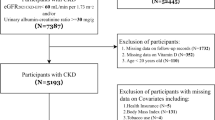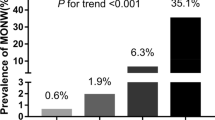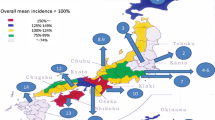Abstract
Background
At present, a growing number of studies have shown a positive association between obesity and kidney stone, while traditional anthropometric measures, such as body mass index (BMI) and Waist circumference (WC), have limited ability to assess the risk of kidney stone. Therefore, this study aimed to investigate the association between the weight-adjusted-waist index (WWI) and the risk of kidney stone.
Method
Data from the National Health and Nutrition Examination Survey (NHANES) between 2009 and 2016 were used. A total of 17,292 participants from NHANES were included in the study. Multivariate logistic regression and restricted cubic splines (RCS) were used to investigate the relationship between WWI and kidney stone. Interaction analysis was performed for subgroups to verify the results. Meanwhile, the receiver operating characteristic curve (ROC) was used to analyze the efficacy of different anthropometric indices in predicting the risk of kidney stone.
Results
After adjusting for potential confounding factors, we found a positive and independent association between kidney stone and WWI. After adjusting for all covariates, a one-unit increase in WWI was associated with a 36% increase in the risk of kidney stones. Dose–response curve analysis showed that WWI was non-linear correlated with the prevalence of kidney stone. In ROC analysis, WWI showed better discrimination for kidney stone (area under the curve: 0.612; 95% CI: 0.599–0.626; optimal cutoff value: 11.063) compared with other indices.
Conclusion
In this study, increased WWI was strongly associated with the risk of kidney stone.


Similar content being viewed by others
Data availability
The original contributions presented in the study are included in the article/Supplementary material; further inquiries can be directed to the corresponding author.
References
Rule AD, Lieske JC, Pais VM (2020) Management of kidney stones in 2020. JAMA 323(19):1961. https://doi.org/10.1001/jama.2020.0662
Sakolish CM, Philip B, Mahler GJ (2019) A human proximal tubule-on-a-chip to study renal disease and toxicity. Biomicrofluidics 13(1):014107. https://doi.org/10.1063/1.5083138
Sakhaee K (2009) Recent advances in the pathophysiology of nephrolithiasis. Kidney Int 75(6):585–595. https://doi.org/10.1038/ki.2008.626
Antonelli JA, Maalouf NM, Pearle MS et al (2014) Use of the national health and nutrition examination survey to calculate the impact of obesity and diabetes on cost and prevalence of urolithiasis in 2030. Eur Urol 66(4):724–729. https://doi.org/10.1016/j.eururo.2014.06.036
Sancak EB, Resorlu M, Akbas A et al (1969) Do hypertension, diabetes mellitus and obesity increase the risk of severity of nephrolithiasis? Pak J Med Sci. https://doi.org/10.12669/pjms.313.7086
De Lorenzo A, Gratteri S, Gualtieri P et al (2019) Why primary obesity is a disease? J Transl Med 17(1):169. https://doi.org/10.1186/s12967-019-1919-y
Cai R, Tang G, Zhang Q et al (2019) A novel Lnc-RNA, named Lnc-ORA, is identified by RNA-Seq analysis, and its knockdown inhibits adipogenesis by regulating the pi3k/akt/mtor signaling pathway. Cells 8(5):477. https://doi.org/10.3390/cells8050477
Fan Y, Futawaka K, Koyama R et al (2016) Vitamin D3/VDR resists diet-induced obesity by modulating ucp3 expression in muscles. J Biomed Sci 23(1):56. https://doi.org/10.1186/s12929-016-0271-2
Oliveros E, Somers VK, Sochor O et al (2014) The concept of normal weight obesity. Prog Cardiovasc Dis 56(4):426–433. https://doi.org/10.1016/j.pcad.2013.10.003
Antonopoulos AS, Oikonomou EK, Antoniades C et al (2016) From the BMI paradox to the obesity paradox: the obesity-mortality association in coronary heart disease: obesity paradox in CHD. Obes Rev 17(10):989–1000. https://doi.org/10.1111/obr.12440
Hainer V, Aldhoon-Hainerová I (2013) Obesity paradox does exist. Diabetes Care 36(Supplement_2):S276–S281. https://doi.org/10.2337/dcS13-2023
Park Y, Kim NH, Kwon TY et al (2018) A novel adiposity index as an integrated predictor of cardiometabolic disease morbidity and mortality. Sci Rep 8(1):16753. https://doi.org/10.1038/s41598-018-35073-4
Kim NH, Park Y, Kim NH et al (2021) Weight-adjusted waist index reflects fat and muscle mass in the opposite direction in older adults. Age Ageing 50(3):780–786. https://doi.org/10.1093/ageing/afaa208
Ding C, Shi Y, Li J et al (2022) Association of weight-adjusted-waist index with all-cause and cardiovascular mortality in china: a prospective cohort study. Nutr Metab Cardiovasc Dis 32(5):1210–1217. https://doi.org/10.1016/j.numecd.2022.01.033
Li Q, Qie R, Qin P et al (2020) Association of weight-adjusted-waist index with incident hypertension: the rural chinese cohort study. Nutr Metab Cardiovasc Dis 30(10):1732–1741. https://doi.org/10.1016/j.numecd.2020.05.033
Zhao P, Shi W, Shi Y et al (2022) Positive association between weight-adjusted-waist index and hyperuricemia in patients with hypertension: the china h-type hypertension registry study. Front Endocrinol 13:1007557. https://doi.org/10.3389/fendo.2022.1007557
Taylor EN, Fung TT, Curhan GC (2009) DASH-style diet associates with reduced risk for kidney stones. J Am Soc Nephrol 20(10):2253–2259. https://doi.org/10.1681/ASN.2009030276
Taylor EN, Stampfer MJ, Mount DB et al (2010) DASH-style diet and 24-hour urine composition. Clin J Am Soc Nephrol 5(12):2315–2322. https://doi.org/10.2215/CJN.04420510
Mitra P, Pal DK, Das M (2018) Does quality of drinking water matter in kidney stone disease: a study in West Bengal, India. Investig Clin Urol 59(3):158. https://doi.org/10.4111/icu.2018.59.3.158
Popkin BM (2010) Recent dynamics suggest selected countries catching up to US obesity. Am J Clin Nutr 91(1):284S-288S. https://doi.org/10.3945/ajcn.2009.28473C
Wagner CA, Mohebbi N (2010) Urinary pH and stone formation. J Nephrol 23(Suppl 16):S165–S169. https://doi.org/10.5167/uzh-45805
Spatola L, Ferraro PM, Gambaro G et al (2018) Metabolic syndrome and uric acid nephrolithiasis: insulin resistance in focus. Metabolism 83:225–233. https://doi.org/10.1016/j.metabol.2018.02.008
Abate N, Chandalia M, Cabo-Chan AV et al (2004) The metabolic syndrome and uric acid nephrolithiasis: novel features of renal manifestation of insulin resistance. Kidney Int 65(2):386–392. https://doi.org/10.1111/j.1523-1755.2004.00386.x
Sakhaee K, Maalouf NM (2008) Metabolic syndrome and uric acid nephrolithiasis. Semin Nephrol 28(2):174–180. https://doi.org/10.1016/j.semnephrol.2008.01.010
Domingos F, Serra A (2014) Metabolic syndrome: a multifaceted risk factor for kidney stones. Scandinavian Journal of Urology 48(5):414–419. https://doi.org/10.3109/21681805.2014.903513
Curhan GC, Willett WC, Rimm EB et al (1998) Body size and risk of kidney stones. J Am Soc Nephrol 9(9):1645–1652. https://doi.org/10.1681/ASN.V991645
Taylor EN, Curhan GC (2006) Body size and 24-hour urine composition. Am J Kidney Dis 48(6):905–915. https://doi.org/10.1053/j.ajkd.2006.09.004
Funding
This work was supported by the Guangdong Medical Research Foundation (A2020223 and A2021435) and Supporting Program of the First Affiliated Hospital of Shantou University Medical College (202003–3).
Author information
Authors and Affiliations
Contributions
WL: protocol/project development, data collection and management, data analysis, and manuscript writing; ML: protocol/project development and manuscript editing; QY: protocol/project development, data collection and management, data analysis, and manuscript writing.
Corresponding author
Ethics declarations
Conflict of interest
The authors report no conflict of interest.
Ethical approval
Studies involving human participants are reviewed and approved by the NCHS Ethics Review Committee.
Informed consent
Informed consent was obtained from all individual participants enrolled in the study.
Additional information
Publisher's Note
Springer Nature remains neutral with regard to jurisdictional claims in published maps and institutional affiliations.
Supplementary Information
Below is the link to the electronic supplementary material.
Rights and permissions
Springer Nature or its licensor (e.g. a society or other partner) holds exclusive rights to this article under a publishing agreement with the author(s) or other rightsholder(s); author self-archiving of the accepted manuscript version of this article is solely governed by the terms of such publishing agreement and applicable law.
About this article
Cite this article
Lin, W., Ye, Q. & Lin, ME. Relationship between the weight-adjusted-waist index and kidney stone: a population-based study. World J Urol 41, 3141–3147 (2023). https://doi.org/10.1007/s00345-023-04620-8
Received:
Accepted:
Published:
Issue Date:
DOI: https://doi.org/10.1007/s00345-023-04620-8




